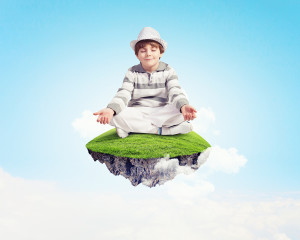
Raising a child can be difficult enough but raising a child with special needs can be especially difficult. A child with ADD or ADHD will often not be able to sit still, have a short attention span, and be very restless. The symptoms of the disorder often affect their learning and social and relationship skills. In other words, their whole world takes on a whole new level of complexity, above and beyond the normal trials and tribulations of childhood.
So what can be done as a parent to help alleviate some of your child’s symptoms? Teaching your child the basics of meditation is certainly a great place to start. Not only does meditation help a child to calm down, focus, and be still, it will also help them to learn how to take control of their emotions and behaviours. This is most commonly accomplished by slowing the breath, relaxing the muscles, and using visualization techniques.
So you’re probably wondering how you would do that exactly. Consider this your crash course in Meditation for Kids 101.
Breathing Meditation:
It’s no secret that in meditation breathing is often the starting and finishing point for all types of meditation, acting as an anchor to help keep us focused on the moment. To simplify this for kids, ask them just to notice what happens physically when they breathe in and out – for example, notice how their chest rises and falls. If your child is quite young, it may help to have them place their hands on their chest/tummy while breathing to physically feel what is happening when they inhale and exhale.
Breathing meditation for restless children
- Keep in mind that a meditation for children (especially restless ones) should be kept short. Start with 1 minute and adjust up or down depending on how your child reacts to it.
- Show your child how to do this meditation and do it along with him.
- Have your child put his hands on his belly and notice how his hands rise and fall as he breathes. You can make this into a little bit of a game by getting him to show you just how big he can make his tummy and then as he breathes out how small he can make his tummy.
A variation on this for older children would be to ask them to breathe in happiness, or another feel good or calming emotion every time they breath in.
Muscle Relaxation:
As they become familiar with their breath, and focus on it, their body, and muscles, will naturally relax, releasing tension. You may need to help them become familiar with their muscles, so they can clench and then release each muscle, one at a time (for example, close the fingers in their hand tight and then release them).
Do this along with your child, showing him the way to Squeeze his
- Hands really tight and let them relax
- Arms in tightly to his body and then relax
- Shoulders right up to their ears, then relax
If your child is still engaged with the activity by the time you get to this point you can add more body parts to make the meditation longer, for example you could have him squeeze his legs tight into his chest, then relax them out on the floor; squeeze his mouth shut tight, then let his mouth drop open. (warning this one might cause some giggling); squeeze his eyes shut tight then relaxed open.
Visualization:
Luckily imagination and childhood go hand in hand, so encouraging your little one to escape into their imagination should be fairly easy. Unlike adults, children don’t think rationally or analytically so imagination is an easy state to transition into. To encourage visualization, ask your child to go a place in their imagination where they feel safe and happy. It can either be a made up place (an elephant riding on the moon) or somewhere familiar to them (the park, grandma’s house). In adult meditation, this type of visualization is often used to help you prepare better for a goal (like visualizing a successful job interview), but in childhood it serves primarily for relaxation and calmness.
- Have your child either sit quietly or lay down on the floor with his eyes closed.
- Ask him to imagine a place that makes him feel safe and happy.
- Guide him through the sensations that would be associated with being in that place, for example what does he hear, see, feel or even smell?
If you would like more ideas and information check out this book Focusing and Calming Games for Children: Mindfulness Strategies and Activities to Help Children to Relax, Concentrate and Take Control
Once you’ve taught your children these techniques, it is a good idea to find a way to add it to their daily routine, for example, before they go to sleep at night. That way these mini meditations will become a familiar habit they can return to them on their own when they need to concentrate, exercise impulse control and problem solving, or simply calm down from feeling anxious or angry. Having this control over their emotions will allow them to better communicate their feelings with you, their siblings, with friends, and at school.
To your inner peace – Anna

 As an adult life can get hectic between working full-time, taking care of kids, running errands and so on there is sometimes not much time left to relax. When that rare moment presents itself, it can be hard to transition into stillness.
As an adult life can get hectic between working full-time, taking care of kids, running errands and so on there is sometimes not much time left to relax. When that rare moment presents itself, it can be hard to transition into stillness.

 Sure, we’ve all had those days where we can’t focus, make rash decisions, and just can’t seem to sit still. But for the 3 – 5 percent of the population, both young and old, living with Attention Deficit Disorder (or ADD) these days are their norm. So where does meditation come into play in all of this? We’re glad you asked! Because meditation can be practiced in many shapes and forms, both still and busy, it can be the perfect means of self-care for those with ADD.
Sure, we’ve all had those days where we can’t focus, make rash decisions, and just can’t seem to sit still. But for the 3 – 5 percent of the population, both young and old, living with Attention Deficit Disorder (or ADD) these days are their norm. So where does meditation come into play in all of this? We’re glad you asked! Because meditation can be practiced in many shapes and forms, both still and busy, it can be the perfect means of self-care for those with ADD.